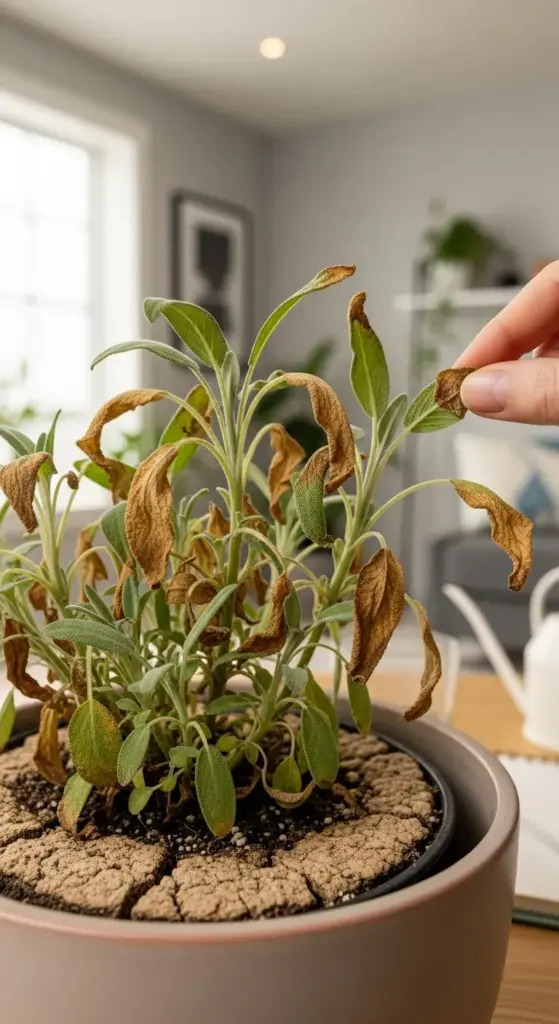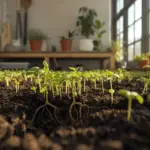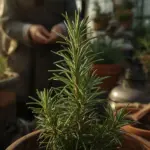Warning Sign #2: Brown, Crispy Leaf Tips Scream Underwatering Crisis

After my overwatering disaster, I swung completely in the opposite direction. I became so paranoid about drowning my sage that I barely gave it any water at all.
The result? Crispy brown leaf tips that looked like someone had taken a lighter to my poor plant. Talk about going from one extreme to another!
Underwatering vs. Low Humidity: The Tricky Diagnosis
Here’s where things get confusing – brown leaf tips can mean two different things. I spent weeks trying to figure out why my sage looked crispy even when I was watering it regularly.
Underwatering damage starts at the tips and edges, but the browning is usually accompanied by wilting and soil that’s bone dry. The leaves feel papery and brittle when you touch them.
Low humidity damage looks almost identical, but the soil might still be moist. This was my “aha!” moment – my apartment’s dry winter air was sucking moisture right out of the leaves faster than the roots could replace it.
The dead giveaway? Humidity issues affect multiple plants in the same area, while underwatering usually hits just the neglected ones.
Creating a Watering Schedule That Actually Works
I tried those fancy plant apps, but honestly, they just stressed me out with constant notifications. Instead, I linked watering to something I already do consistently – Sunday meal prep.
Every Sunday while my coffee brews, I do the finger test on all my herbs. If the soil is dry 2 inches down, they get water. Simple as that.
Seasonal adjustments are crucial though. During summer, my sage needs water twice a week. In winter, once a week is plenty because the heating system dries everything out faster.
I keep a small notebook by my plants with watering dates. Sounds nerdy, but it helped me spot patterns – like how my sage always needs water exactly 4 days after the last watering in July.
DIY Humidity Hacks Using Stuff You Already Have
The pebble tray method saved my sanity and my sage. I grabbed a shallow dish, filled it with decorative stones from my garden, and added water just below the stone tops.
The plant sits on top, never touching the water directly. As the water evaporates, it creates a humidity bubble around your sage. I refill the tray every few days.
Grouping plants together also works wonders. I moved my sage next to my pothos and spider plant, and they all started looking healthier. Plants naturally release moisture, so they help each other out.
My weirdest trick? I put a small humidifier near my herb collection during winter months. Got it for $25 at Target, and it runs for 8 hours on one fill.
Temperature and Seasonal Water Needs
Summer was brutal for my sage – air conditioning and hot windows created this weird cycle of dry air and intense heat. I had to water almost every 3 days during heat waves.
Winter is the opposite problem. Heating systems suck moisture from the air, but the plant’s growth slows down so it needs less water. I learned this after killing a sage with kindness in January.
Room temperature matters more than I realized. My sage near the sunny kitchen window needed water twice as often as the one in my cooler bedroom. Location, location, location!
I started checking the soil temperature with my finger – cold soil holds moisture longer, while warm soil dries out fast.
Emergency Revival for Severely Dehydrated Sage
When I found my sage completely wilted with soil that was hard as concrete, I panicked. But here’s what actually worked: bottom watering instead of pouring water on top.
I filled a tray with lukewarm water and let the pot sit in it for 30 minutes. The soil absorbed water slowly from the bottom up, which prevented shock from sudden moisture changes.
Never flood a severely dehydrated plant – I learned this the hard way. The roots can’t handle going from bone dry to soaking wet instantly.
After the emergency watering, I moved the plant to bright, indirect light and misted the leaves lightly. Within 6 hours, the wilting stopped, and new growth appeared within a week.
The key is patience. Severely stressed sage can take 2-3 weeks to fully recover, even with perfect care.
Think you’ve got watering figured out? Click “next” to discover why your sage might be getting leggy and stretched out – and it has nothing to do with water! The lighting mistake I made will probably sound familiar…









GIPHY App Key not set. Please check settings